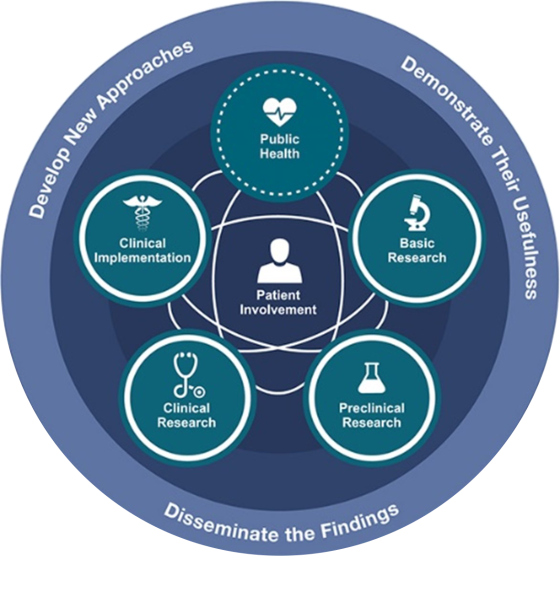Translational Research is a commonly used term in medical research which explains how researchers ‘translate’ basic science discoveries from the laboratory into clinical application. The purpose of this research is to improve how we prevent and diagnose health conditions, discover new treatments, and improve the way we help patients for better outcomes. Health and medical research is more likely to be translated into practice and have greater real-world impact when it responds to locally prioritised needs and is shaped by the people who will use and benefit from the research.
Translational research accelerates innovation in healthcare. Implementation of the new knowledge highlighting new methods in clinical best practice published in journals, guidelines and government reports delivers benefit to patients.
Policy communication and advocacy have a large part to play in ensuring that such research has its desired impact on society. In other instances, a technology solution may be the route to address a particular problem. This is where internal innovation generating new intellectual property and collaboration with industry has a large part to play in converting new inventions into life-improving products serving patients’ needs.
Our research focus areas: big data; biomedical science; childhood cancer; mental health and neurosciences; next-generation technologies, imaging, and precision medicine; and virtual care research translated to excellence in clinical care.
We aspire to:
- Deliver person-centred research (and subsequent care) by putting people and their families at the centre of decisions, planning and development. Creating equal partnerships and improving the way professionals and patients think about care and their relationships. Making the experience as important as the outcome. Ensuring people are involved in- and central to- their care is now recognised as a key component of developing high quality healthcare.
- Undertake holistic research that investigates the impact of education, the natural and built environment, lifestyle and social-economic factors, and social networks on wellbeing in our communities. We will use this knowledge to produce innovative interventions in health.
- Incorporate data generated from routine clinical care and record-keeping with novel information platforms to enhance diagnosis, treatment and evaluation, and lead to new discoveries.
- Lead innovation in health and wellness, care and delivery, treatment and diagnostics. Focusing on less-invasive treatments and procedures, harnessing creativity and technology, reducing cost, increasing collaboration across and outside of RHIP, supporting ideas pipeline and keeping patients out of hospitals.
Read more in our Translational Research Strategy.
Case Study
Spinal Muscular Atrophy: Newborn Screening Program
From 1 July 2022, parents of all new babies in NSW and the ACT will be offered free tests for both Severe Combined Immunodeficiency (SCID) and Spinal Muscular Atrophy (SMA) within 48-72 hours of their baby’s birth. This is the direct result of translational research led by Associate Professor Michelle Farrar, that showed testing and treating newborns for spinal muscular atrophy is saving lives and healthcare costs.
SMA is a type of motor neurone disease that, up until 2018, was the most common cause of infant genetic death. There is no known cure for SMA, which affects around one in 10,000 newborns in Australia. Without treatment, most babies with type 1 SMA – the most common type of the disease – don’t make their second birthday. Medical advances in gene therapy – a type of therapy that replaces the defective gene with a functioning copy – have given hope to families, with a recent trial showing that most treated infants are meeting normal infant developmental milestones. But the SMA drug comes with a big price tag: in the United States, it costs $US2.1 million, where it’s the most expensive single-dose treatment in the world.
Gene therapy for SMA might have a high up-front price tag. But by screening and treating infants early, the therapy can save both lives and money in the long term. But now, new research shows that testing all Australian newborns for this disease, and using the gene therapy for early treatment, is still cheaper in the long run than our current treatment methods – and better yet, it will help save lives.
“SMA is currently only diagnosed and treated once symptoms appear. But by the time an infant or child with SMA presents with symptoms, they’ve already lost 90 per cent of their nerves. Our study shows that new therapies like gene therapy aren’t only getting the best benefit for patients diagnosed early, but also for society,” says co-author Associate Professor Michelle Farrar, a paediatric neurologist based at UNSW and Sydney Children's Hospital.
For more information on translational research at RHIP, please contact:
Celia Loneragan
Translational Research Lead
celia.loneragan@unsw.edu.au
